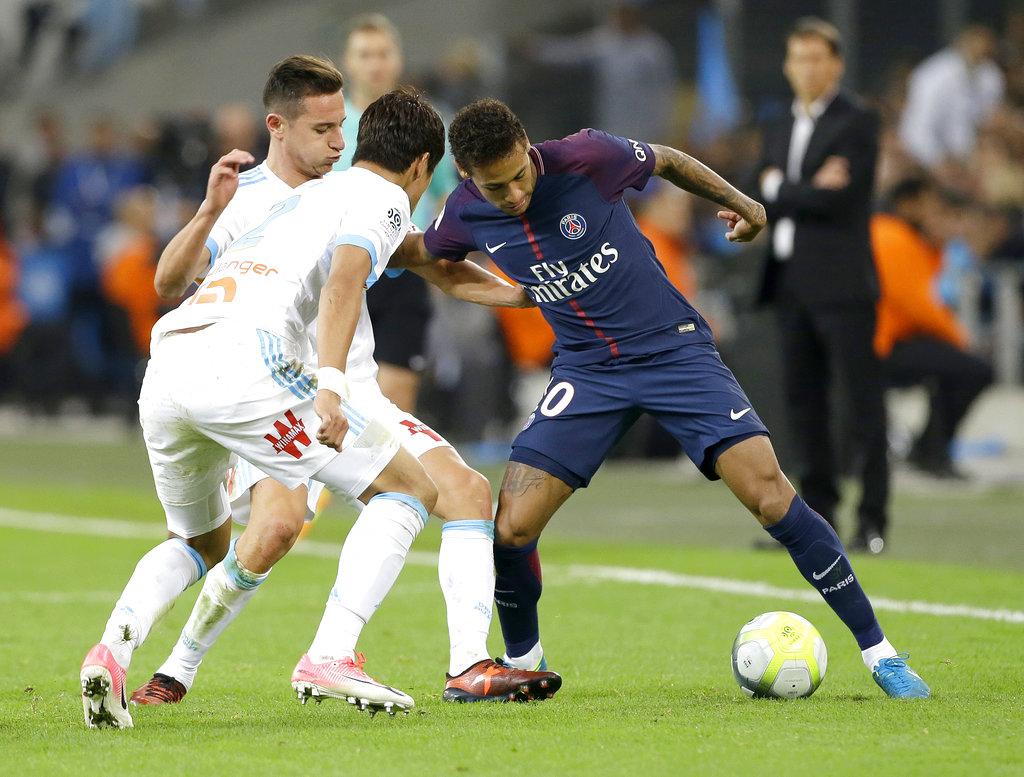
FILE – A Sunday, Oct. 22, 2017 file photo showing PSG’s Neymar, right, challenging for the ball with Marseille’s Hiroki Sakai, left, and Marseille’s Florian Thauvin, during the League One soccer match between Marseille and Paris Saint-Germain, at the Velodrome stadium, in Marseille. The biggest statement came from PSG which more than doubled the previous transfer record by splurging 222 million euros on Neymar _ an unexpected windfall for Barcelona but a deal that solidified the power shifts. (AP Photo/Claude Paris, File)
Footballing supremacy between nations will be determined in 2018, just maybe not in the way expected.
The World Cup remains the ultimate prize in sport, and a Russia buffeted by doping scandals and geopolitical rifts will open up like never before to welcome thousands of fans.
When the tournament reaches its climax in Moscow on July 14, the biggest global television audience of the year is likely to see the World Cup handed over.
Will Germany be the first team to retain the title since Brazil in 1962? Can Neymar inspire Brazil to a record-extending sixth success? Will the players who have shared major individual honors for a decade — Cristiano Ronaldo (Portugal) and Lionel Messi (Argentina) — finally become world champions?
But it became clearer in 2017 that appearing at the World Cup is no longer the only vehicle — or preferred means — for countries to validate their status and strength in the world’s biggest sport.
That isn’t much of a reassurance, though, for Italy, the Netherlands and the United States who failed to qualify for Russia.
The international soccer landscape is being reshaped by the Gulf state-funded clubs, and their clout reached new heights in the last year.
Just as Qatar and the United Arab Emirates became ensnared in a diplomatic standoff, the jewels in their soccer crowns slugged it out in the transfer market pursuing the top talent.
Around $300 million was spent in the summer transfer window alone by both Manchester City, which is owned by the UAE’s Abu Dhabi, and Paris Saint-Germain, which is funded by 2022 World Cup host nation Qatar.
The biggest statement came from PSG which more than doubled the previous transfer record by splurging 222 million euros on Neymar — an unexpected windfall for Barcelona but a deal that solidified the power shifts.
Both PSG and City have already obliterated the field in their French and English leagues respectively and are racing toward regaining their domestic titles. The true test of power in this intriguing rivalry between energy-rich Gulf powers should be determined in the Champions League. The competition has been won in three of the last four years by Real Madrid, and the holders now stand in the way of PSG reaching the quarterfinals in March.
Madrid and Barcelona remain in the control of their fans, a structure able to resist foreign ownership, although both teams have accepted injections of cash through UAE or Qatar sponsorships.
The future spending capabilities of the nascent forces at PSG and City will be determined in the coming months. However wealthy their ownership, unfettered spending remains subject to curbs in an often forlorn attempt to maintain a competitive balance in competitions and prevent them stockpiling players.
The ultimate threat hanging over PSG is exclusion from the Champions League unless it balances the books by cashing in on stars in the January transfer window. PSG’s legal team is already preparing to take the fight to UEFA over its implementation of Financial Fair Play rules, having faced an earlier round of punishments — along with City — in 2014 that led to limits on the squad size and financial penalties.
UEFA has also served notice on AC Milan that sanctions could be looming after around $250 million was spent in the summer by new private Chinese investors. Milan is an illustration of why authorities don’t want clubs risking their financial health in the pursuit of success. Despite the investment, Milan is closer to the relegation zone than the top four Champions League qualification places halfway through the Serie A season.
City is in a more advantageous position than either PSG or Milan due to its cut from domestic television rights. The Premier League is banking 8.3 billion pounds ($11 billion) from broadcasters under the current three-year deals, far eclipsing European counterparts.
One of the early defining moments of 2018 in soccer won’t happen on the field but in the Premier League’s negotiations over the 2019-2022 rights. The winning outlets will provide an indicator of the vitality of traditional networks in an era of fragmented viewing habits where streaming platforms are luring viewers. The value of the deals will also influence the spending power of clubs in the coming years and the destination of the players.
The flow of cash from Abu Dhabi since 2008 has already produced the dominant City team imagined by Sheikh Mansour. At the start of the second half of the season, Pep Guardiola’s side enjoys a commanding lead over the previously pre-eminent Manchester United.
How rapidly fortunes change in soccer.
Guardiola, a serial title winner at Barcelona and Bayern Munich, was facing doubts over his managerial prowess as he opened his City reign with his first trophyless season. He remains on course for a quadruple at the second attempt.
Across Manchester, it was Jose Mourinho buoyant in the first half of 2017 after collecting the Europa League and League Cup to offset a sixth-place domestic finish. But Mourinho enters 2018 in sullen mood, seething with envy about the lavish investment from Abu Dhabi that enabled Guardiola to remodel his squad.
It’s another indicator that with all the cash pumped into soccer by Gulf ruling families, the World Cup can no longer be relied on to determine the true kings of soccer in 2018.